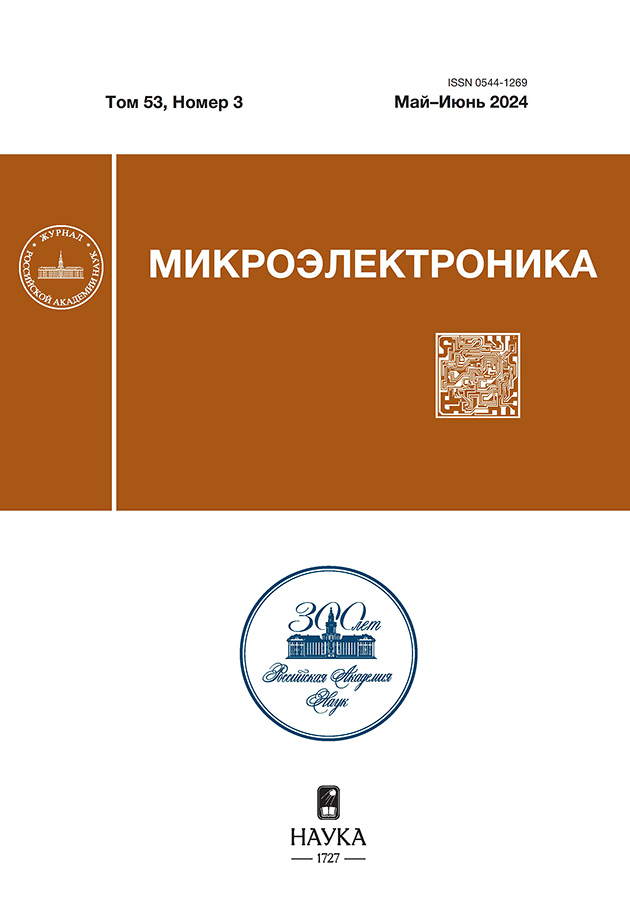Разработка приборной структуры Ge-МДПТ с индукцированным каналом p-типа
- Авторы: Алябина Н.А.1, Архипова Е.А.2, Бузынин Ю.Н.1,2, Денисов С.А.1, Здоровейщев А.В.1, Титова А.М.1, Чалков В.Ю.1, Шенгуров В.Г.1
-
Учреждения:
- Нижегородский государственный университет им. Н.И. Лобачевского
- Институт физики микроструктур РАН
- Выпуск: Том 53, № 3 (2024)
- Страницы: 259-264
- Раздел: ПРИБОРЫ
- URL: https://rjonco.com/0544-1269/article/view/655226
- DOI: https://doi.org/10.31857/S0544126924030077
- ID: 655226
Цитировать
Полный текст
Аннотация
Определены условия роста методом HW CVD слоев Ge n-типа проводимости с параметрами, требуемыми для создания Ge-МДП-транзистора с индуцированным каналом p-типа. Оптимизированы условия осаждения методом электронно-лучевого осаждения и последующего отжига слоев подзатворного high-k диэлектрика ZrO2:Y2O3, позволяющие достигнуть величины тока утечки 5 × 10–6 А/см2. Для разработанной приборной структуры проведен расчет некоторых параметров Ge-МДП-транзистора, таких как длина канала, максимальное напряжение между стоком и истоком, пробивное напряжение.
Ключевые слова
Полный текст
Об авторах
Н. А. Алябина
Нижегородский государственный университет им. Н.И. Лобачевского
Email: asya_titova95@mail.ru
Россия, Нижний Новгород
Е. А. Архипова
Институт физики микроструктур РАН
Email: asya_titova95@mail.ru
Россия, Нижегородская обл., д. Афонино
Ю. Н. Бузынин
Нижегородский государственный университет им. Н.И. Лобачевского; Институт физики микроструктур РАН
Email: asya_titova95@mail.ru
Россия, Нижний Новгород; Нижегородская обл., д. Афонино
С. А. Денисов
Нижегородский государственный университет им. Н.И. Лобачевского
Email: asya_titova95@mail.ru
Россия, Нижний Новгород
А. В. Здоровейщев
Нижегородский государственный университет им. Н.И. Лобачевского
Email: asya_titova95@mail.ru
Россия, Нижний Новгород
А. М. Титова
Нижегородский государственный университет им. Н.И. Лобачевского
Автор, ответственный за переписку.
Email: asya_titova95@mail.ru
Россия, Нижний Новгород
В. Ю. Чалков
Нижегородский государственный университет им. Н.И. Лобачевского
Email: asya_titova95@mail.ru
Россия, Нижний Новгород
В. Г. Шенгуров
Нижегородский государственный университет им. Н.И. Лобачевского
Email: shengurov@phys.unn.ru
Россия, Нижний Новгород
Список литературы
- Неизвестный И.М. Германиевый полевой транзистор с изолированным затвором (Ge МДПТ) // Вестник СибГУТИ. 2009. № 3. С. 5—9.
- Goley P.S., Mantu K.H. Germanium Based Field-Effect Transistor: Challenges and Opportunities // Materials. 2014. № 7. С. 2301—2339.
- Yi S.H., Chang-Liao K.S., Wu T.Y., Hsu C.W., Huang J. High performance Ge pMOSFETs with HfO2/Hf-Cap/GeOx gate stack and suitable post metal annealing treatments // IEEE Trans Electron Devices. 2017. № 37. P. 544—547.
- Liu H., Han G., Liu Y., Hao Y. High Mobility Ge pMOSFETs with ZrO2 Dielectric: Impacts of Post Annealing Nanoscale Research Letters. 2019. V. 14. P. 202.
- Shin Y., Chung W., Seo Y., Lee C.H., Sohn D.K., Cho B.J. Demonstration of Ge pMOSFETs with 6 Å EOT using TaN/ZrO2/Zr-cap/n-Ge(100) gate stack fabricated by novel vacuum annealing and in-situ metal capping method // IEEE Symposium on VLSI Technology. 2014. P. 82—83.
- Lin C.M., Chang H.C., Chen Y.T., Wong I.H., Lan H.S., Luo S.J., Lin J.Y., Tseng Y.J., Liu C.W., Hu C., Yang F.L. Interfacial layer-free ZrO2 on Ge with 0.39-nm EOT, κ ~ 43, ~2 × 10–3 A/cm2 gate leakage, SS = 85 mV/dec, Ion/Ioff = 6 × 105, and high strain response. Electron Devices Meeting (IEDM) // 2012 IEEE International. 2012. P. 23.2.1—23.2.4.
- Henkel C., Abermann S., Bethge O., Pozzovivo G., Klang P., Reiche M., Bertagnolli E. Ge p-MOSFETs with scaled ALD La2O3/ZrO2 gate dielectrics // IEEE Trans Electron Devices. 2010. V. 57. P. 3295—3302.
- Seo Y., Lee T.I., Yoon C.M., Park B.E., Hwang W.S., Kim H. The impact of an ultrathin Y2O3 layer on GeO2 passivation in Ge MOS gate stacks // IEEE Trans Electron Devices. 2017. V. 64. P. 3303—3307.
- Kamata Y. High-k/Ge MOSFETs for Future Nanoelectronics // Materials today. 2008. V. 11. Nos. 1-2 P. 31—38.
- Wu N., Zhang Q., Chan D.S.H., Balasubramanian N., Zhu C. Gate-First germanium nMOSFET with CVD HfO2 gate dielectric and silicon surface passivation // IEEE Electron Device Letters. 2006. V. 27. № 6. P. 479—491.
- Kamata Y. High-k/Ge MOSFETs for future nanoelectronics // Materials Today. 2008. V. 11. № 1. P. 30—38.
- Buzynin A.N., Osiko V.V., Buzynin Y.N. Fianite: a multipurpose electronics material // Bulletin of the Russian Academy of Sciences: Physics. 2010. V. 74. № 7. P. 1027—1033.
- Buzynin A.N., Buzynin Y.N., Panov V.A. Applications of Fianite in Electronics. Advances in OptoElectronics. Vol. 2012. P. 23.
- Buzynin Y., Shengurov V., Zvonkov B., Buzynin A., Denisov S., Baidus N., Drozdov M., Pavlov D., Yunin P. GaAs/Ge/Si Epitaxial Substrates: Development and Characteristics. Green and Sustainable Chemistry. 2017. V. 7. № 3. 015304.
- Титова А.М., Денисов С.А., Чалков В.Ю., Алябина Н.А., Здоровейщев А.В., Шенгуров В.Г. Распределение концентрации носителей заряда в эпитаксиальных слоях Ge и GeSn, выращенных на n+-Si(001)-подложках // Физика и техника полупроводников. 2022. V. 56. № 9 P. 339—343.
- Bean J.C., Leamy H.J., Poate J.M., Rozgonyi G.A., Sheng T.T., Williams J.S., Celler G.K. Epitaxial laser crystallization of thin‐film amorphous silicon // Applied Physics Letters. 1978. V. 33. P. 227—230.
- Никифоров А.И., Кантер Б.З., Стенин С.И. Получение многослойных кремниевых структур методом молекулярно-лучевой эпитаксии // Электронная промышленность. 1989. № 6. P. 3—5.
Дополнительные файлы














